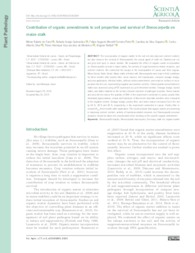Contribution of organic amendments to soil properties and survival of Stenocarpella on maize stalk.
Contribution of organic amendments to soil properties and survival of Stenocarpella on maize stalk.
Author(s): FARIA, M. R. de; GUIMARÃES, R. A.; PINTO, F. A. M. F.; SIQUEIRA, C. da S.; SILVA, C. A.; MEDEIROS, F. H. V.; BETTIOL, W.
Summary: Abstract: The incorporation of organic matter to the soil not only improves nutrient content, but also reduces the survival of Stenocarpella, the causal agent of stalk rot, Diplodia ear rot, and grey leaf spot, in maize stubble. We evaluated the effect of organic waste incorporation on Stenocarpella survival in maize stalks, the activity of suppressiveness-related enzymes, and nutrient contents. We conducted the assays in the municipalities of Lavras and Sete Lagoas, Minas Gerais State, Brazil. Maize stalks infested with Stenocarpella were kept in field conditions for three months after poultry litter, swine manure, fish hydrolysate, compost sewage sludge, and urea application. Infested stalks, without residue amendment, were kept on surface or incorporated into the soil, representing negative and positive controls. Stenocarpella concentration in stalks was assessed using qPCR expressed as cycle threshold number. Sewage sludge, buried stalks, and stalks retained on the surface showed reduction of pathogen inoculum. Swine manure and urea did not reduce the quantity of DNA. In the experiment conducted in Lavras, poultry litter stimulated ?-glucosidase, urease and hydrolysis of fluorescein diacetate activities when compared to the negative control. Sewage sludge, poultry litter, and swine manure increased Ca in the soil by 44 %, 38 % and 36 %, respectively, in the experiment conducted in Lavras. Poultry litter increased Ntotal three months after application. The results indicate that organic wastes are promising in improving nutrient content, activity of hydrolysis-related enzymes, but Stenocarpella inoculum dynamics should be taken into consideration when deciding on the specific organic amendment.
Publication year: 2020
Types of publication: Journal article
Unit: Embrapa Environment
Observation
Some of Embrapa's publications are published as ePub files. To read them, use or download one of the following free software options to your computer or mobile device. Android: Google Play Books; IOS: iBooks; Windows and Linux: Calibre.
Access other publications
Access the Agricultural Research Database (BDPA) to consult Embrapa's full library collection and records.
Visit Embrapa Bookstore to purchase books and other publications sold by Embrapa.

